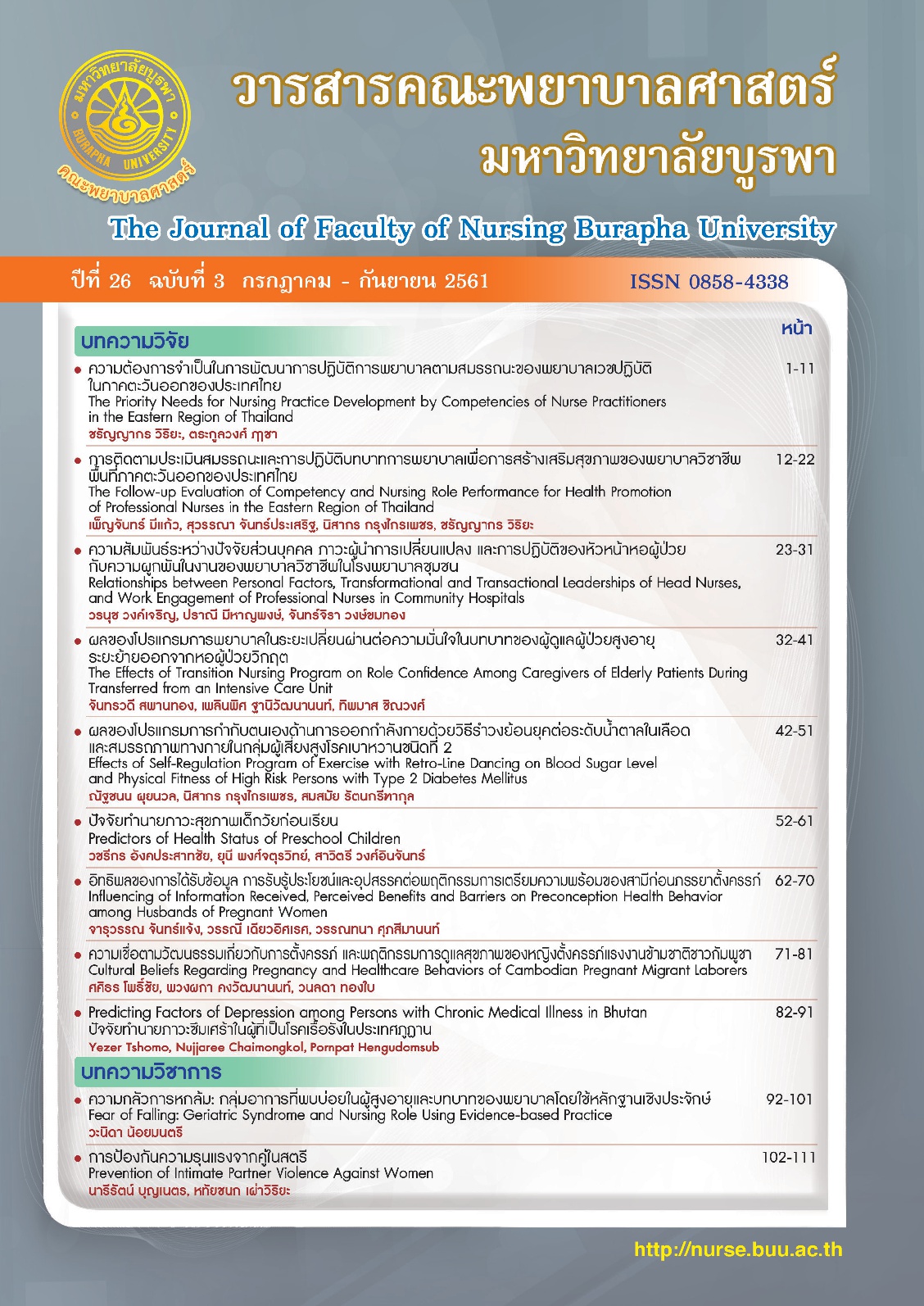อิทธิพลของการได้รับข้อมูล การรับรู้ประโยชน์และอุปสรรคต่อพฤติกรรมการเตรียมความพร้อมของสามีก่อนภรรยาตั้งครรภ์
คำสำคัญ:
สามีของสตรีตั้งครรภ์, พฤติกรรมการเตรียมความพร้อมก่อนตั้งครรภ์, การได้รับข้อมูล, การรับรู้ประโยชน์, การรับรู้อุปสรรคบทคัดย่อ
บทคัดย่อ
การวิจัยครั้งนี้มีวัตถุประสงค์เพื่อศึกษาพฤติกรรมการเตรียมความพร้อมของสามีก่อนภรรยาตั้งครรภ์ และอิทธิพลของการได้รับข้อมูล การรับรู้ประโยชน์ และการรับรู้อุปสรรคต่อพฤติกรรมการเตรียมความพร้อมของสามีก่อนภรรยาตั้งครรภ์ กลุ่มตัวอย่างคัดเลือกแบบสะดวกจำนวน 85 ราย คือสามีของสตรีตั้งครรภ์แรกที่ภรรยามารับบริการ ณ แผนกฝากครรภ์ โรงพยาบาลเอกชนแห่งหนึ่ง เก็บข้อมูลโดยใช้แบบสอบถามข้อมูลทั่วไป การรับรู้ประโยชน์ การรับรู้อุปสรรค การได้รับข้อมูล และพฤติกรรมการเตรียมความพร้อม มีค่าความเชื่อมั่นเท่ากับ .72 .79 .74 และ .87 ตามลำดับ วิเคราะห์ข้อมูลด้วยสถิติพรรณนาและการวิเคราะห์ถดถอยพหุคูณ
ผลการวิจัยพบว่า พฤติกรรมการเตรียมความพร้อมของกลุ่มตัวอย่างมีค่าเฉลี่ยเท่ากับ 6.47 (SD = 2.2) ซึ่งอยู่ในระดับดี พฤติกรรมที่ปฏิบัติมากที่สุดคือ การงดหรือลดใช้สารเสพติด (ร้อยละ 95.3) และพฤติกรรมที่ปฏิบัติน้อยที่สุดคือ การฉีดวัคซีนไวรัสตับอักเสบบี (ร้อยละ 34.1) การได้รับข้อมูล การรับรู้ประโยชน์ และการรับรู้อุปสรรค สามารถร่วมกันทำนายพฤติกรรมการเตรียมความพร้อมของสามีก่อนภรรยาตั้งครรภ์ได้ร้อยละ 19.9 (R2 = .199, F3,81= 6.72, p< .01 ) ปัจจัยทำนายปัจจัยเดียวที่มีนัยสำคัญทางสถิติคือการได้รับข้อมูลจากหลายแหล่งเกี่ยวกับการเตรียมความพร้อมของสามีก่อนภรรยาตั้งครรภ์ (b= .29, p< .01) พยาบาลที่ให้การดูแลสุขภาพของคู่สมรสก่อนภรรยาตั้งครรภ์ควรให้ความสำคัญกับการให้ข้อมูลแก่สามีเพื่อการเตรียมความพร้อมก่อนภรรยาตั้งครรภ์
เอกสารอ้างอิง
(2015). Men aged 15–44 in need of preconception care. Maternal and Child Health Journal, 19, 2358–2365.
Ding, Y., Tian, X., Xie, F. L., & Yangc, Y. (2015). Survey on the implementation of
preconception care in shanghai, china. Paediatric and Perinatal Epidemiology, 29,
492 – 500.
Frey, K. A., Navarro, S. M., Kotelchuck, M., & Lu, M. C. (2008). The clinical content of
preconception care: Preconception care for men. American Journal of Obstetrics
Gynecology, supply to December, S389-S395.
Janz, N. K., & Becker, M. H. (1984). The health belief model: A decade later. Health
Education Quarterly, 11(1), 1-47.
Knezovich, J. G., & Ramsay M. (2012). The effect of preconception paternal alcohol exposure
on epigenetic remodeling of the H19 and Rasgrf1 imprinting control regions in
mouse offspring. Frontiersin In Genetics, 3, 1-10.
Loadee, N., Sriareporn, P., & Parisunyakul, S. (2010). Perceived benefits and barriers of
preconception health care among reproductive aged females. The Journal of Faculty of Nursing Burapha University, 18(3), 1-16. [In Thai]
Mitchell, E. W., Levis, D. M., & Prue, C. E. (2012). Preconception health: Awareness, planning,
and communication among a sample of US men and women. Maternal and Child Health Journal, 16(1), 31-39.
Thai Health Promotion Foundation. (2559). Secondhand Smoke. Retrieved from
http://www.thaihealth.or.th/node/6875 [In Thai]
Toivonen, K. I., Oinonen, K. A., & Duchene, M. D. (2017). Preconception health behaviors: A
scoping review. Preventive Medicine, 96, 1-15.
World Health Organization. (2013). Preconception care: maximizing the gains for maternal
and child health. Retrieved from http://www.who.int/maternal_child_adolescent/
documents/preconception_care_policy_brief.pdf.





